02 Jul Saint John’s Church : Where Charnock Lies
Kolkata’s Most Historical Church
Saint John’s Church may not be the first church to be built in Kolkata (in fact it’s the third) but it is certainly the most historical.
It was built in 1784 beside the imposing Governor House (now Raj Bhavan), on land that was donated to Governor William Hastings by Maharaja Nabo Kishen Bahadur, which, in the words of the church’s current vicar, Reverend Pradip Nanda, may have been both a gift and some “give and take”.
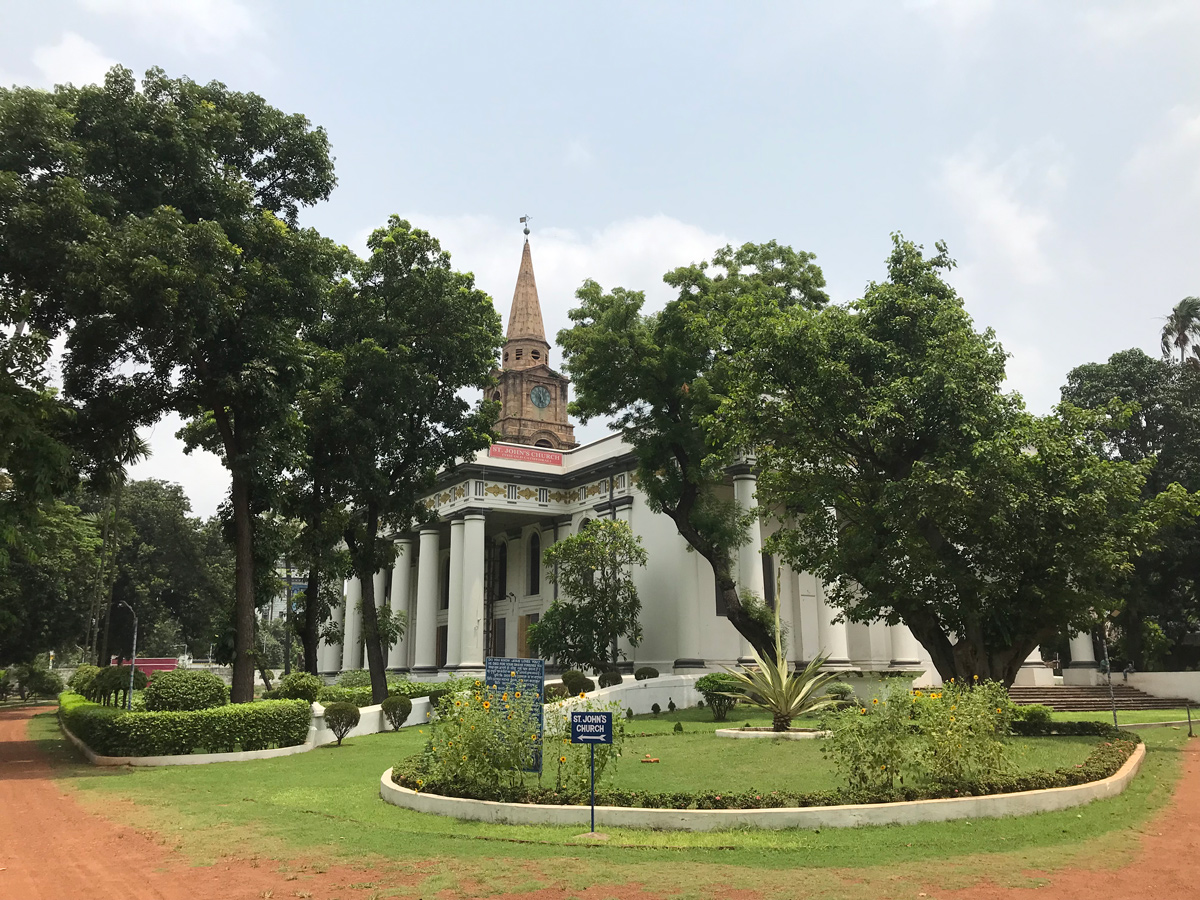 The Neatly Maintained Grounds of Kolkata’s Most Historic Church
The Neatly Maintained Grounds of Kolkata’s Most Historic Church
At the time, Kolkata clearly needed a new and bigger church. There were 4,000 people from England living in the city with more arriving every month. Kolkata was thriving as the capital of British India and the military hub. It had an established Supreme Court, and academic institutions like the Asiatic Society were being formed. The city even had enough English readers to have its own English newspaper in the Bengal Gazette.
I visited St John’s Church on a hot and steamy June morning and found its vast grounds a haven of fruit trees and well manicured lawns. Mynas were strutting around on the green grass and squirrels scampered in the foliage. There were mango trees all around me with fruit ripe to be picked hanging in bunches. I could spot papaya, jamun and bael and massive kathal (jackfruit) tree.
Neat blue signs pointed to the main attractions and every corner seemed worth a visit.
Start By Viewing The Black Hole of Calcutta Memorial
Every school kid in India has read about the “black-hole-of Calcutta” incident, when the Nawab of Bengal, Siraj ud daulah, locked up a number of English prisoners in a small dungeon at Fort William for the night.
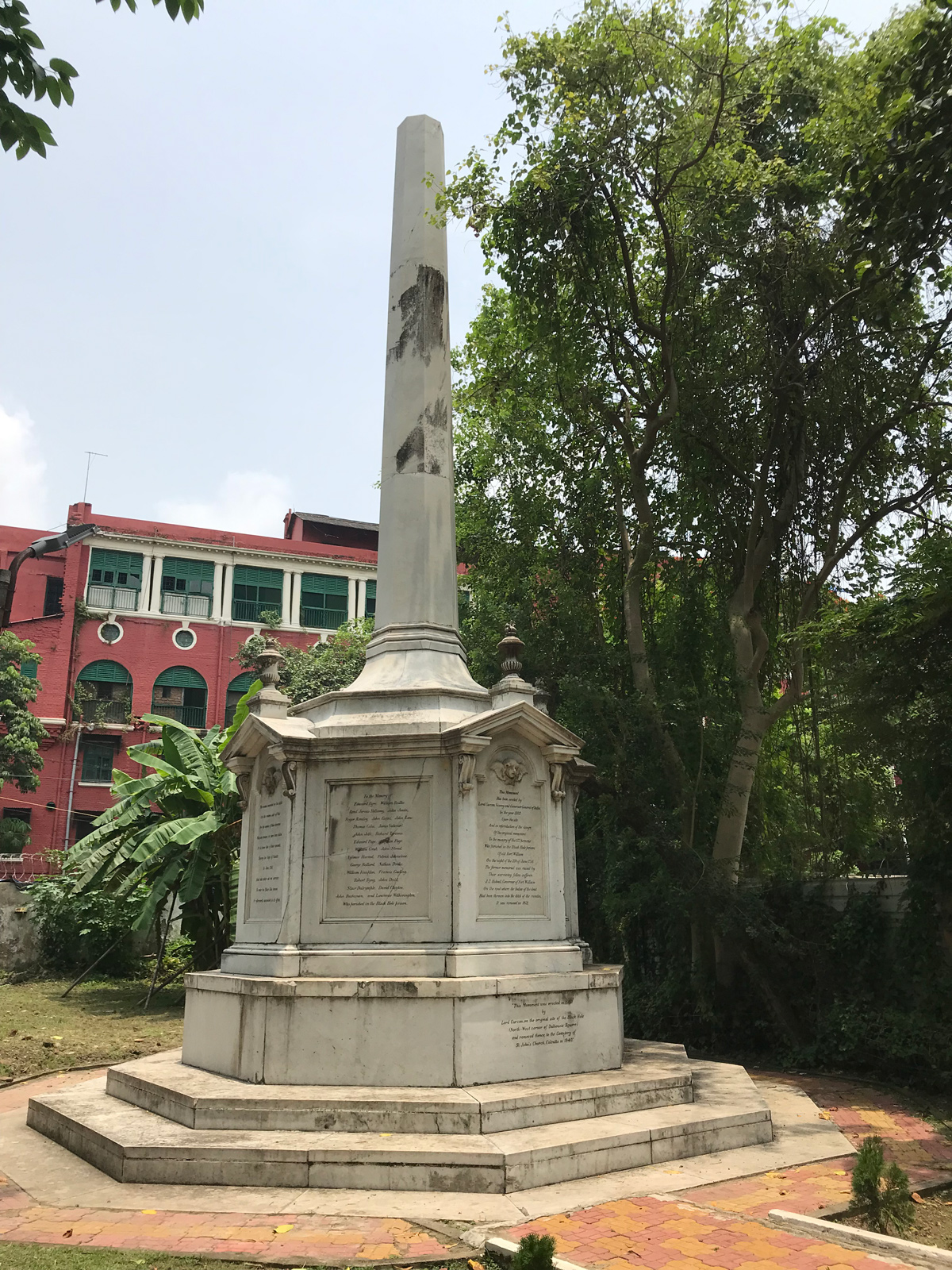 This Black Hole Monument was Erected by Curzon in 1902 as a Replica of the Original, Bought Here in 1940
This Black Hole Monument was Erected by Curzon in 1902 as a Replica of the Original, Bought Here in 1940
Siraj ud daulah was angered by the English building fortifications at Fort William and had ordered them to stop, claiming they were traders and should remain as such. The English ignored him, leading to the Nawab marching to Kolkata from Murshidabad to teach them a lesson.
Fort William was sacked on June 20, 1757 and the Governor in-charge, William Drake and his military commander Captain Minchin infamously took flight, rowing out in to the Hooghly to make their escape. Their fellow-Englishman were left behind to face the wrath of Siraj.
What happened next is controversial, with historians on both sides insisting they are right. The English believe that 146 English prisoners were squeezed in to a small room where many died of suffocation and only 23 survived. The alternative theory is that no such incident happened – even if prisoners were taken and confined, they were far fewer in number.
Either way, the black-hole-of-Calcutta story got burnished in to folklore and a monument was erected by the English to remember the dead. It’s curious though that the monument lists just 43 dead instead of hundreds. Later, at the height of the freedom movement in 1940, the English decided to shift the monument from its location near the GPO to St John’s Church, where it now stood in front of me, at the end of a neatly paved path.
Move On To Job Charnock’s Tomb
Job Charnock may or may not was the founder of Kolkata, but he definitely led an amazing life.
Born in Lancashire, England, in 1630, Charnock “wandered abroad on soil not his own” as the inscription on his tomb so quaintly puts it, to arrive in Patna with the East India Company in 1658. He spent 22 long years in Patna as an Englishman isolated in the midst of Indians, picking up all manners of “native customs”.
Charnock married an Indian lady whom he dramatically saved from performing sati, re-named her Maria and lived with her for 19 years. They had four children.
His compatriot, Alexander Hamilton, writes disapprovingly that “…instead of converting her to Christianity, she made him a proselyte to paganism, and the only part of Christianity remarkable in him, was burying her decently, and he built a tomb over her, where all his life after her death, he kept the anniversary day of her death by sacrificing a cock on her tomb.”*
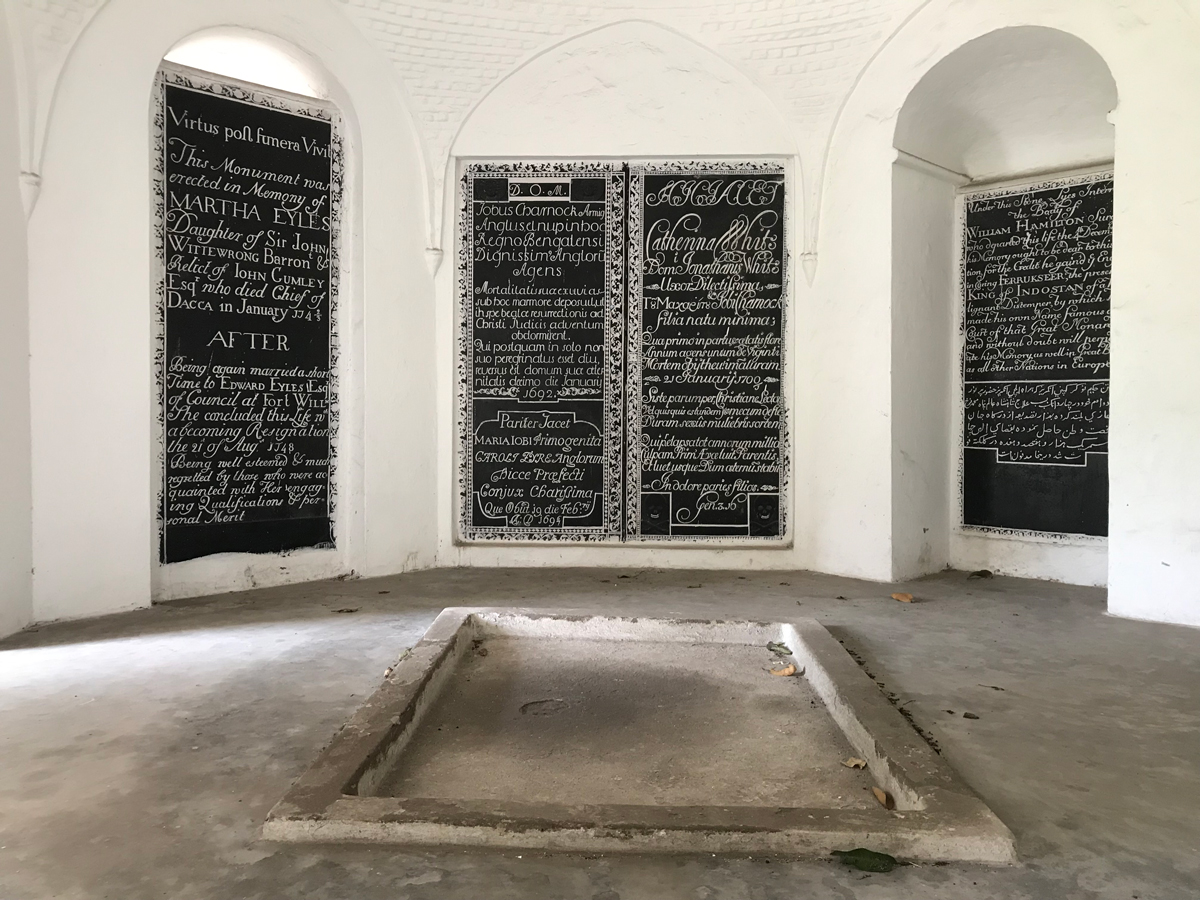 Here Rests Job Charnock With his Daughters, At the End of a Dramatic Life
Here Rests Job Charnock With his Daughters, At the End of a Dramatic Life
From Patna, Charnock spent some years at the Company factory in Cossimbazar, before landing at the village Sutanati on the banks of the Hooghly on August 24, 1690, to “found” Kolkata or at least provide it and the adjoining villages with a vision and dynamism that transformed it to one of India’s main cities.
Charnock died in Kolkata in 1692 and was buried here. His mausoleum was erected a few years later by his son-in-law Charles Eyre. It is one of the oldest pieces of masonry in Kolkata and pre-dates St John’s Church. Charnock’s three daughters married in Kolkata and died here too. They are interred with him in this grave.
 Charnock’s Mausoleum, Erected 1695, Pre-Dates St John’s Church, And Is One Of The Oldest Pieces of Masonry in Kolkata
Charnock’s Mausoleum, Erected 1695, Pre-Dates St John’s Church, And Is One Of The Oldest Pieces of Masonry in Kolkata
Interestingly, the shiny black tombstone inscribed with Charnock’s details in Latin are brought here all the way from Pallavaram near Chennai. This type of stone has been named “Charnockite” by geologists.
The Remarkable Begum Johnson Is Buried Close To Charnock…
Begum Johnson was such a notable citizen of Kolkata that though this graveyard was closed in 1767, the gates were opened in 1812 specially to allow for her burial, as that was her wish. Governor General Lord Minto himself was in attendance at the burial.
Begum Johnson was born as Frances Croke in 1757 and lived till the age of 87, marrying four times and outliving her husbands.
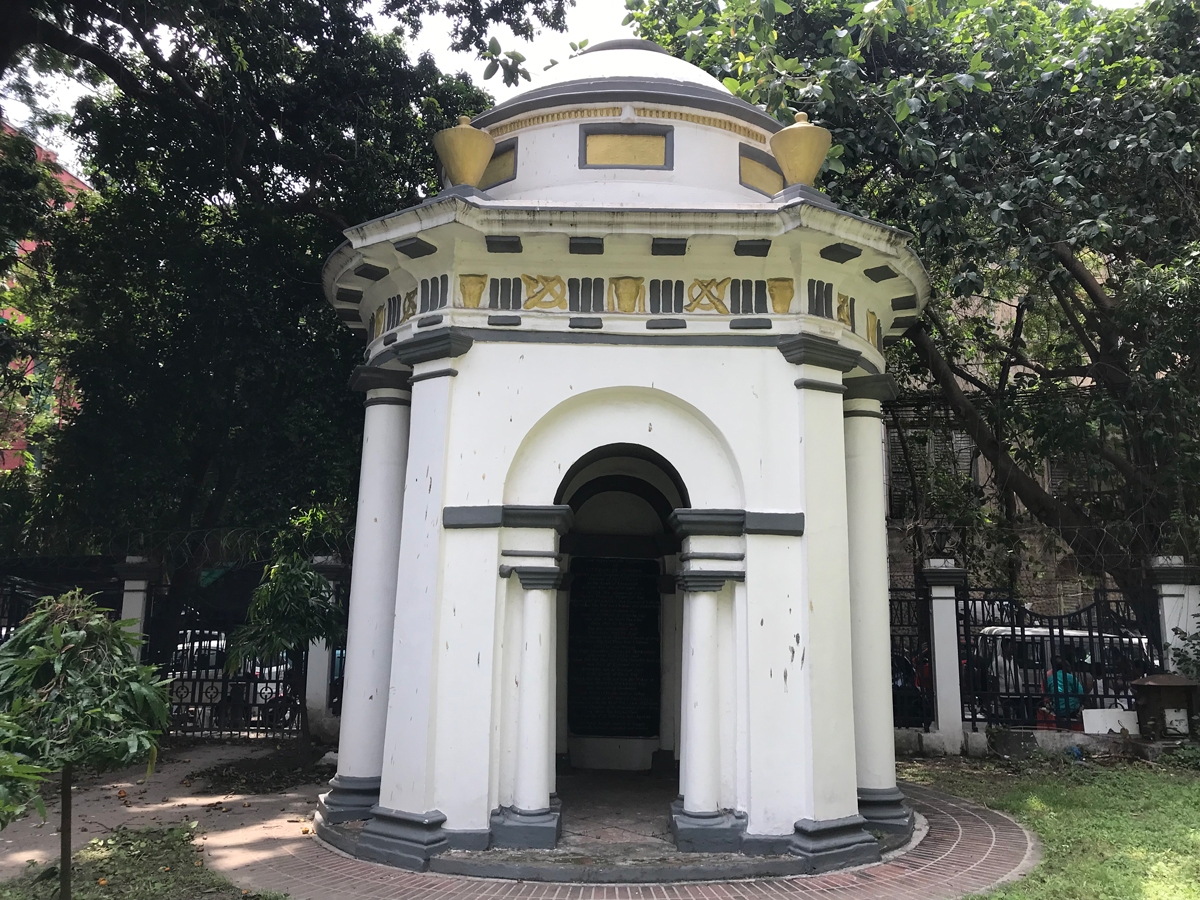
Begum Johnson Outlived Four Husbands: “Universally Respected Beloved and Revered”
Frances’s first two marriages were short affairs, both ending with the untimely death of the husband. She first wed the wonderfully named Parry Purple Templar, nephew of the Governor of Calcutta. Her second husband, James Altham, died of small pox a few weeks after the marriage.
By the age 24, Frances was widowed twice. Her third marriage to William Watts was her longest and bore her three children, with one of her grandchildren going on to become an English Prime Minister.
Watts was a senior official of the East India Company and a close confidante of Robert Clive. He had played a crucial role in the intrigue leading up to the overthrow of Siraj ud daulah at the Battle of Plassey and was the key man for all secret discussions with the turncoat, Mir Jafar. Like Clive, Watts too made huge sums of money with the English victory at Plassey and he decided to return to England with his loot.
Frances Johnson accompanied her husband “home”, except England was never really home for her. They built an impressive mansion at South Hill Park, near London, that still exists as a prominent Arts Center. Watts died in a few years and Frances, after continuing in England for five more years, took the very unusual decision (for the time) to return to India.
In 1769, ten years after she had left, Frances was back in Kolkata. Meanwhile, an energetic Oxford-educated clergyman, Reverend William Johnson, had also arrived in the city. Reverend Johnson was a prime mover in the construction of St John’s Church, on the very grounds of which his wife’s grave now rests.
Frances and Reverend Johnson wed in in 1774. It was her final marriage and gave her the name “Begum Johnson”. Unfortunately for the Begum, once the church was completed, Johnson too started pining to go “home”. This time Frances would have none of it, and the couple arrived at an understanding. Frances paid the Reverend an annuity for him to leave for England without her and never come back. This neatly sidestepped the messy issue of divorce, which for a clergyman was an absolute no-no, and allowed both to go their own way.
Begum was now 59 years old. She lived out her remaining years in style in Kolkata. When she breathed her last, she was “the oldest British Resident in Bengal; universally beloved, respected and revered”.
Inside the Church…
I entered the coolness of the silent and empty church to sit on its wooden pews. Instead of the normal wooden benches, this had individual chairs with a footrest. Directly in front of me was the famous painting of the Last Supper by Johann Zoffany, in which he has apparently substituted the faces of the apostles with leading members of Kolkata’s society of the time.
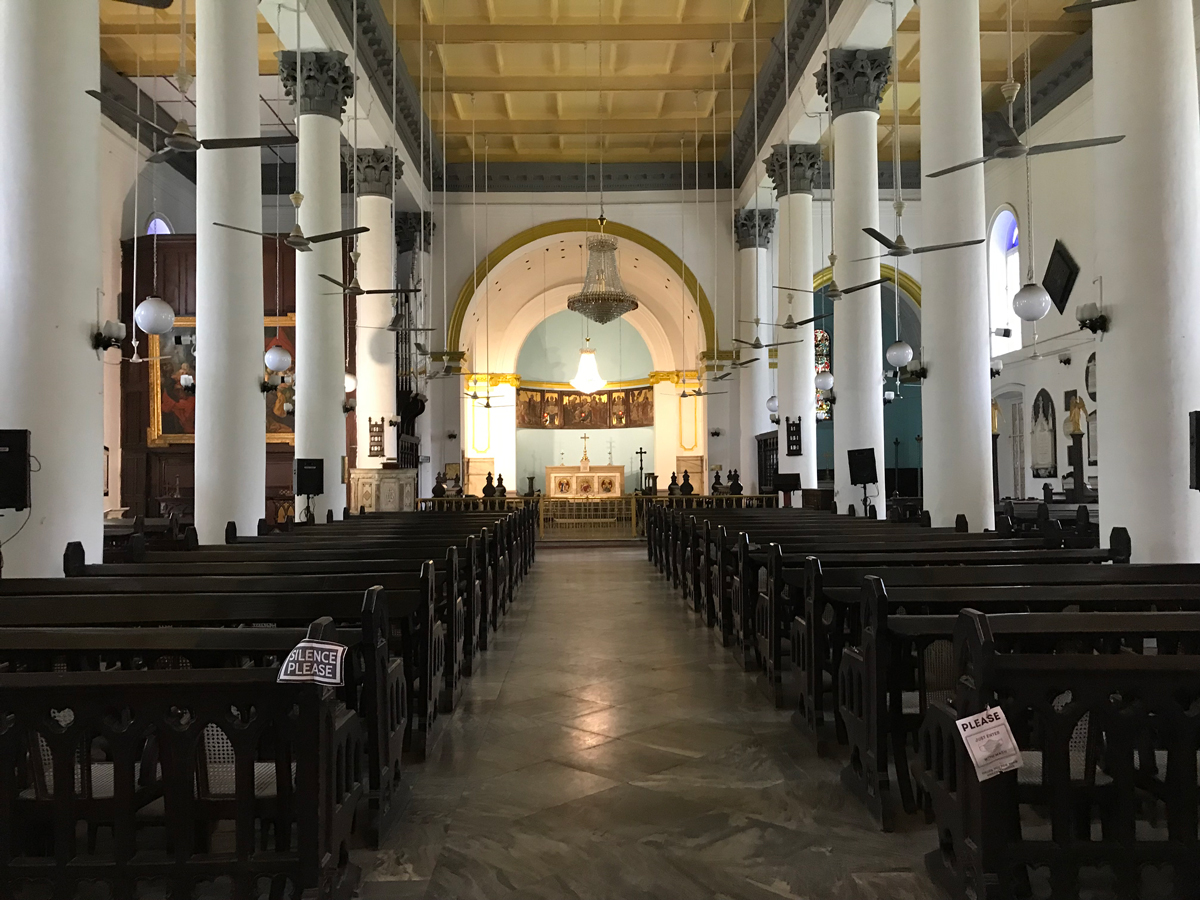
The Reflective Solitude of St John’s Church
Sitting alone in the stillness of the church, I tried to imagine life on these grounds 200 years ago. The church’s consecration ceremony was on a Sunday, June 24, 1787, and was quite a gathering. Lord Cornwallis himself carried the legal seal of the Archbishop of Canterbury and among those present was the diarist William Hickey who wrote this colorful dispatch of his attendance :
“we accordingly remained pouring down claret until eight in the morning Sunday…at nine three carriages being announced ready, upon mustering the party no more could be prevailed upon to proceed than five…we rapidly conveyed to the church, the steps of which we were able to ascend by leaning upon and supporting each other. It may easily be believed that in such a state we exposed ourselves, drawing the eyes and attention of the congregation upon us as well as that of the clergyman who took occasion to introduce in his sermon a severe philippic against inebriety, against indelicate behavior in a sacred place…and directing those parts of his discourse pointedly to the pew in which we sat.”*
I looked around the silent pews, wondering where Hickey and his friends would have sat. They would clearly have been out of sync with the rest of the crowd, for attending St John’s Church was a chic occasion for the posh crowd of Kolkata. The sahibs and memsahibs would arrive at the church in their palanquins for which a special palanquin slope had been built to alight in style – “…you brought at least seven servants with you – four chair bearers, two running footman, with spears and one parasol bearer…alighting at the great eastern staircase of Chunar stone you ascended under the screen of your huge painted parasol to a tile paved terrace…where a sentry with a firelock guarded the entrance”*
Stories The Wall Plaques Tell Us
The memorials on the walls of St John’s Church honor past army generals who fell in war, members of The Bengal Civil Service, judges of the Supreme Court as well as everyday worshippers who died in Kolkata.
But some of these tablets are specially intriguing….
Spare a thought for the unfortunate George Cracroft Aubert, his eulogy written “in testimony of affection and regret”, for he had at the very young age of 25, “…died on the evening of the 29th of April 1843, riding homeward from the residence of a friend, was overtaken by a sudden storm, and, with horse which bore him, was struck dead by lightening.”
And also the curious case of Andrew Stirling, who died at the age of 36 in 1830, having served his office “…distinguished by great talents, urbanity of manners and excellence of disposition” having held the position of “Persian Secretary to the Government and Deputy Secretary in the Secret and Political Department”. The name of the Department says it all…what mysterious transactions was he up to?
The Vestry Room, Which Was Earlier Hastings’ Office…
On my way out of the church, I met Reverend Pradip Nanda, its enthusiastic vicar. We sat and chatted in his office, with him explaining to me how the church was run and what it takes to be a vicar.
Reverand Nanda got his theological degree from Serampore college, a four-year course that trains in Hebrew and Greek (for the Old and New Testaments) along with sociology, theology and the more practical aspects of financially managing a church. He mentioned that administering the St John’s Church with its vast grounds costs about Rs 2 Lakh a month, and with the current congregation size being just twenty people, the revenues from subscriptions do not add up. So, the church seeks additional funds through parking fees and has also digitized its records for marriages, births and deaths and charges a fee for access.
While we were talking, a huge basket of freshly picked mangoes was carried in to the office, making the whole room smell of the fruit. Earlier, while walking the grounds, I had seen men climb the trees to shake the fruit loose – the mangoes falling with a thud on the grass. These mangoes were kept aside by the Reverend, the next day being a Sunday, to be distributed to members who came for the congregation.
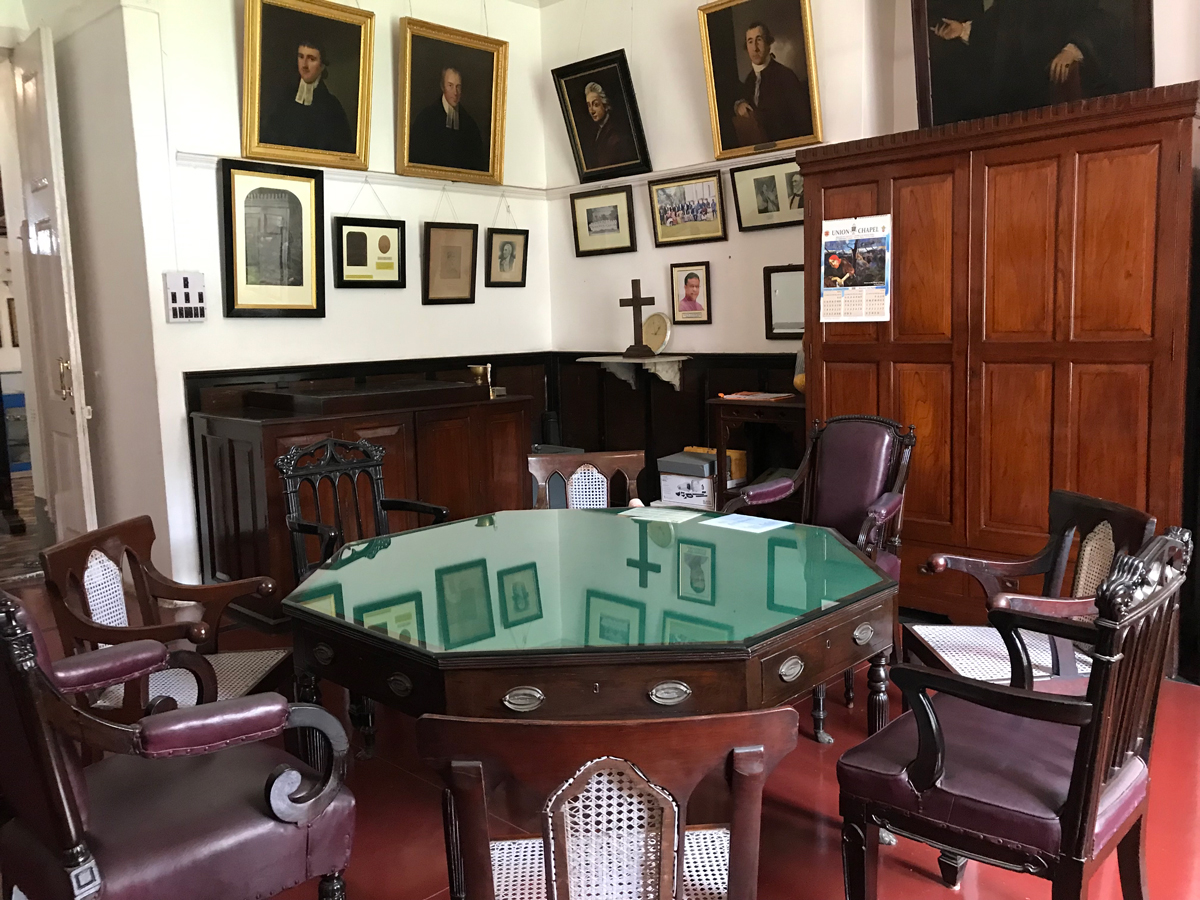 William Hastings’ Office : Now The Vestry Room
William Hastings’ Office : Now The Vestry Room
Reverend Nanda told me about the vestry and had the room opened for me. The vestry of a church is where the priest’s ceremonial robes are kept, and this room was originally William Hastings’ office. Hastings sahib’s original chair can still be seen behind a protective glass.
I took in the wood-paneled office with its octagonal table and wall portraits, and wondered about the politics that would have been conducted here. For Hastings governorship was full of conspiracies; his running battle with his own council for Calcutta – specially Francis Phillip who whom he even had a pistol duel on a misty Kolkata morning; the dismissal of a combative James Hickey, a ferocious critic of Hastings and publisher of the Bengal Gazette, who was silenced through the courts with the blessings of Hastings’s friend and the head of the Supreme Court, Elijah Impey. The episode of Nandkumar, who had accused Hastings of taking bribes, and was tried and executed in eight days flat by the same Sir Elijah, with whispers of judicial murder.
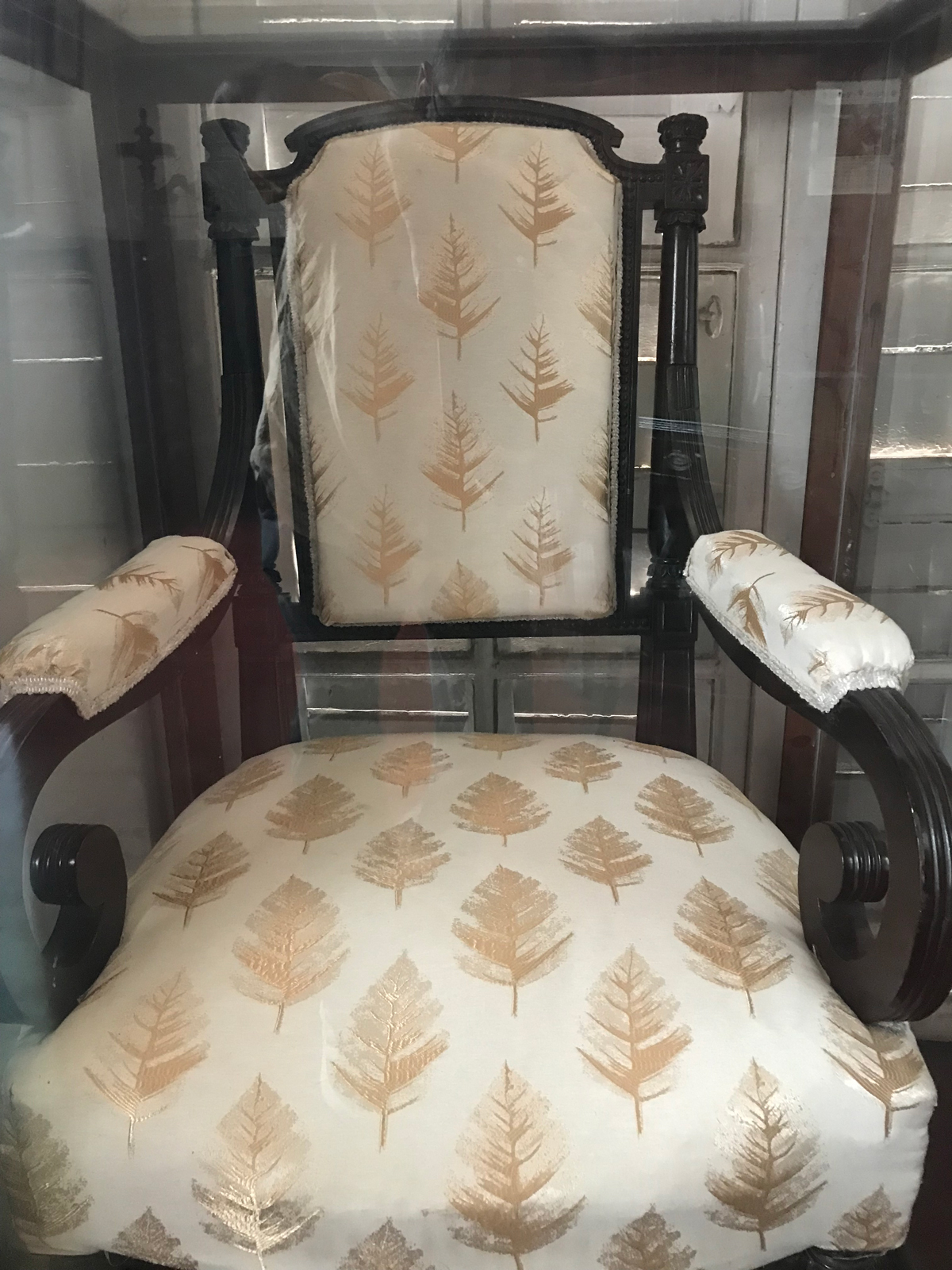 The Chair Of The Mighty Hastings : The Plots and Intrigues Of Office
The Chair Of The Mighty Hastings : The Plots and Intrigues Of Office
What intense deliberations would these walls have witnessed? I imagined an anxious William Hastings, sitting and brooding in his chair, surrounded by his coterie all sweating in the heat while they plotted the next move.
* “European Calcutta” by Dr Dhrubajyoti Banerjea (page8, page 114, 115)
Information:
- Open all days, 10am to 4pm.
- Toilet facilities available
- Wheelchair access available
- Ample parking available within the grounds
Sources:
- “Calcutta”. By Geoffrey Moorehouse Published by Faber&Faber
- “European Calcutta – Images and Recollections of a Bygone Era”. By Dr Dhrubajyoti Banerjea. Published by UBS Publishers.
- “The Anarchy – The East India Company, Corporate Violence, and The Pillage of an Empire”. By William Dalrymple. Published by Bloomsbury.
- “Hicky’s Bengal Gazzette”. By Tarun Kumar Mukhopadhyay.

